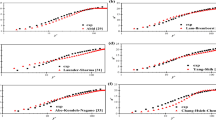Abstract
In this paper we report on (two-component) LDV experiments in a fully developed turbulent pipe flow with a drag-reducing polymer (partially hydrolyzed polyacrylamide) dissolved in water. The Reynolds number based on the mean velocity, the pipe diameter and the local viscosity at the wall is approximately 10000. We have used polymer solutions with three different concentrations which have been chosen such that maximum drag reduction occurs. The amount of drag reduction found is 60–70%. Our experimental results are compared with results obtained with water and with a very dilute solution which exhibits only a small amount of drag reduction.
We have focused on the observation of turbulence statistics (mean velocities and turbulence intensities) and on the various contributions to the total shear stress. The latter consists of a turbulent, a solvent (viscous) and a polymeric part. The polymers are found to contribute significantly to the total stress. With respect to the mean velocity profile we find a thickening of the buffer layer and an increase in the slope of the logarithmic profile. With respect to the turbulence statistics we find for the streamwise velocity fluctuations an increase of the root mean square at low polymer concentration but a return to values comparable to those for water at higher concentrations. The root mean square of the normal velocity fluctuations shows a strong decrease. Also the Reynolds (turbulent) shear stress and the correlation coefficient between the stream wise and the normal components are drastically reduced over the entire pipe diameter. In all cases the Reynolds stress stays definitely non-zero at maximum drag reduction. The consequence of the drop of the Reynolds stress is a large polymer stress, which can be 60% of the total stress. The kinetic-energy balance of the mean flow shows a large transfer of energy directly to the polymers instead of the route by turbulence. The kinetic energy of the turbulence suggests a possibly negative polymeric dissipation of turbulent energy.
Similar content being viewed by others
Author information
Authors and Affiliations
Rights and permissions
About this article
Cite this article
Ptasinski, P., Nieuwstadt, F., van den Brule, B. et al. Experiments in Turbulent Pipe Flow with Polymer Additives at Maximum Drag Reduction. Flow, Turbulence and Combustion 66, 159–182 (2001). https://doi.org/10.1023/A:1017985826227
Issue Date:
DOI: https://doi.org/10.1023/A:1017985826227




